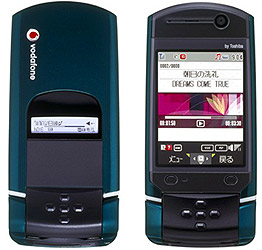Our 5th Birthday!
 This week marked a major milestone for WWJ! In one form or another, I’ve been writing this email newsletter for five years — and what a five year term it’s been!
This week marked a major milestone for WWJ! In one form or another, I’ve been writing this email newsletter for five years — and what a five year term it’s been!
I spent a couple hours last night looking over past WWJ newsletters, and was struck by how much Japan’s mobile scene has changed. In 2001, when I started writing a weekly mobile-focused newsletter for J@pan Inc, i-mode had just celebrated its second birthday, KDDI had yet to roll out CDMA 1X services and the No. 3 competitor in the market was known as “J-Phone.”
Today, DoCoMo is far in the lead with their 3G FOMA service and music and TV are the new hot trends; i-mode itself has become almost dasai (uncool). KDDI have created one of the mightiest and most unified mobile platforms on Earth, with GPS-based blogging, shopping and PC Internet integration drawing huge usage. The company formerly known as J-Phone is about to become the company formerly known as Vodafone as Masayoshi Son attacks 3G mobile with the same successful discount focus with which he attacked NTT and home broadband.
Bonus ‘those were the days’ tidbits via the WWJ Newsletter after the jump!


 For Vodafone Japan, the end came not with a bang, but with a whimper. When we arrived at last Monday’s press event – the final one, it turned out, before news of the Japan sell-out hit the Web – the smell of pending doom hung in the air. Ironically, the media briefing bore an optimistic title: the “Future Direction of Product & Service Development.” It was also surprising to see that President Bill Morrow and Chairman Tsuda-san would attend for the 3G roadmap briefing to be given by former J-Phone super-star Ohta-san; WWJ has never seen three Vodafone Big Guys in one room together for a media briefing (perhaps there is safety in numbers)? But when the talk from all three turned out vague and totally avoided any mention of new MVNO’s signing up to resell Vodafone 3G capacity — widely considered to be one of Big Red’s few viable options in Japan — we suspected something was up.
For Vodafone Japan, the end came not with a bang, but with a whimper. When we arrived at last Monday’s press event – the final one, it turned out, before news of the Japan sell-out hit the Web – the smell of pending doom hung in the air. Ironically, the media briefing bore an optimistic title: the “Future Direction of Product & Service Development.” It was also surprising to see that President Bill Morrow and Chairman Tsuda-san would attend for the 3G roadmap briefing to be given by former J-Phone super-star Ohta-san; WWJ has never seen three Vodafone Big Guys in one room together for a media briefing (perhaps there is safety in numbers)? But when the talk from all three turned out vague and totally avoided any mention of new MVNO’s signing up to resell Vodafone 3G capacity — widely considered to be one of Big Red’s few viable options in Japan — we suspected something was up. Tomi Ahonen is a smart guy who’s done a lot of observing and thinking about the 3G future. He reports that planet Earth has 2 bn mobile phones, with more phones in use than cars, credit cards or televisions, and that advertisers, businesses and governments are all trying to understand how the mobile future will download. For a glimpse into the future, Tomi was in Tokyo last month for the
Tomi Ahonen is a smart guy who’s done a lot of observing and thinking about the 3G future. He reports that planet Earth has 2 bn mobile phones, with more phones in use than cars, credit cards or televisions, and that advertisers, businesses and governments are all trying to understand how the mobile future will download. For a glimpse into the future, Tomi was in Tokyo last month for the 
